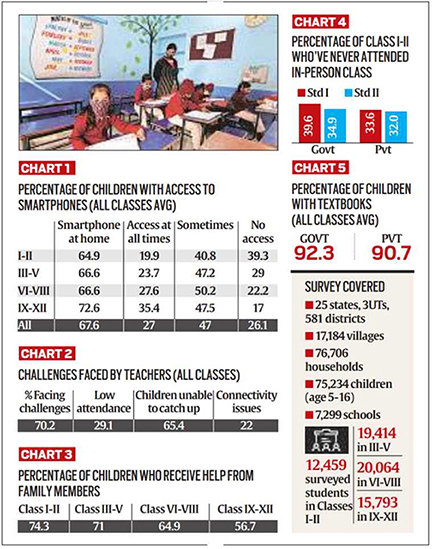20
Nov
Covid-19 Impact on Learning: ASER 2021
Covid-19 Impact on Learning: ASER 2021
Recently, the 16th edition of the Annual Status of Education Report (ASER 2021) survey was released. The survey analysed the impact of Covid-19 on learning.
- It shows an increase in dependence on private tuitions and an absence of ready access to smartphones.
- Specific attention is needed to help make up for learning losses, especially in the lowest classes.
Annual Status of Education Report (ASER) Survey
- The ASER survey, which is facilitated by Pratham Education Foundation, is the oldest survey of its kind in the country.
- It is well regarded for the range of insights it provides on levels of foundational learning at the elementary level.
- It uses Census 2011 as the sampling frame and continues to be an important national source of information about children’s foundational skills across the country.
- ASER 2018 surveyed children in the age group of 3 to 16 years and included almost all rural districts in India and generated estimates of foundational reading and arithmetic abilities of children in the age group 5 to 16 years.
- ASER 2019 reported on the pre-schooling or schooling status of children in the age group 4 to 8 years in 26 rural districts, focused on the “early years” and laid emphasis on “developing problem-solving faculties and building a memory of children, and not content knowledge”.
- ASER 2020 is the first ever phone-based ASER survey and it was conducted in September 2020, the sixth month of national school closures.
Key Points
- Increasing Enrollment in Government School:
- There was an unprecedented jump in government school students, and a 10-year low in private school enrolments.
- A clear shift from private to government schools — from 64.3% in 2018 to 65.8% in 2020, to 70.3% in 2021.
- A fall in private school enrolment from 28.8% in 2020 to 24.4% in 2021.
- Tuition-dependent:
- It has reported a growing dependency on private tuition classes.
- Students, especially those from poor families, are dependent more than ever on private tuition.
- Digital Divide:
- There exists a stark digital divide, which carries the risk of severely affecting the learning abilities of primary grade students.
- Almost a third of all children in Classes I and II did not have a smartphone available at home.
- Problems with New Entrants:
- From having no experience of pre-primary class or anganwadis to the lack of access to digital devices, the pandemic has left the youngest entrants in India’s formal education system particularly vulnerable.
- 1 in 3 children in Classes I and II have never attended an in-person class.
- Students who entered the school system after the pandemic will require time to settle down, get ready for the formal education system.
- Learning Gap:
- 65.4% teachers flagged the problem of children being “unable to catch up” as one of their biggest challenges.
- This is also a warning that their learning outcomes are set to be affected unless addressed with urgency.
- During the recent National Achievement Survey (NAS) of the central government, teachers and field investigators across the country reported that primary grade kids struggled to make sense of questions to test basic comprehension and numerical skills.
- Positive Trend: The report captured a decline in the proportion of children not currently enrolled in the 15-16 age group. This is one of the sections which faces the highest risk of dropping out.
- In 2010, the proportion of 15-16-year-olds who were out of school was 16.1%.
- Driven by the government’s push to universalise secondary education, this number has been steadily declining and stood at 12.1% in 2018. The decline continued in 2020 to 9.9% and to 6.6% in 2021.

- Related Government Initiatives:
- SWAYAM
- NEAT
- National Knowledge Network, (NKN)
- PRAGYATA Guidelines
- National Programme on Technology Enhanced Learning
Way Forward
- A Multi-Pronged Approach: Flexible rescheduling the academic timetable and exploring options in collaboration with schools, teachers, and parents for providing access to education to a larger section of students.
- Giving priority to the less advantaged students who do not have access to e-learning.
- Making Online Education More Effective: Shorter but quality discussions rather than long hours of monotonous sitting and one-way communication, should be preferred.
- The teacher’s role has to go beyond just being in control of the class to being a facilitator for the transfer of knowledge.
- Focussing more on Knowledge Aspect: Education is not about competence but more about motivation. The students are meant to discover not just cover the syllabus.
